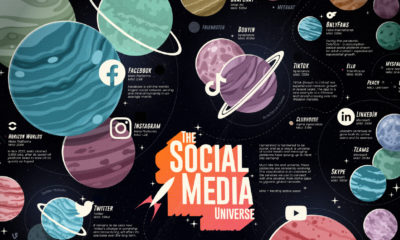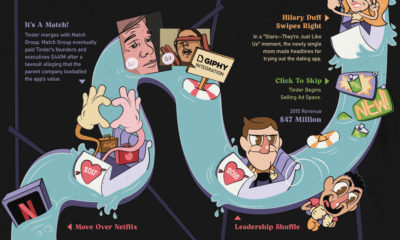Profile picture NFTs are pieces of digital artwork that people use to express themselves online. Each item is a depiction of a character’s face, and has a unique mix of attributes that gives it a sense of collectability. Like other NFTs, they’re secured on a blockchain and can be bought and sold for cryptocurrency. And while there’s nothing to stop you from screenshotting an NFT and using it for your own profile, the market for these items continues to grow. To learn more, this infographic explains how three well-known profile picture NFT collections were created.
CryptoPunks
CryptoPunks are commonly regarded as one of the first examples of NFTs. The collection consists of 10,000 unique “punks” and was released in 2017 by Larva Labs. One interesting fact is that these NFTs were originally given out for free—today, they are worth thousands or millions of dollars each. According to OpenSea, one of the largest NFT marketplaces, CryptoPunk #3100 was sold for 4,200 Ethereum (roughly $7.6 million) in March 2021. A large component of #3100’s perceived value is its blue alien skin, which only eight other punks have. In other words, it’s incredibly rare. The following table shows the species distribution of the CryptoPunks collection. In addition to species, each punk features a unique mix of facial accessories or “attributes”. Examples include a big beard (found in only 146 punks), and a VR headset (found in 332 punks).
Bored Ape Yacht Club
Next is the Bored Ape Yacht Club (BAYC), another collection of 10,000 unique profile picture NFTs. Unlike CryptoPunks, BAYC NFTs show both the head and torso of a character (in this case, an ape). This opens up many combinations of clothing items, facial features, and accessories. Altogether, there are seven categories of attributes: Background color, Clothes, Earring, Eyes, Fur, Hat, and Mouth. The following table lists some examples of BAYC attributes, and their % rarity. To explore further, visit the BAYC gallery. BAYC NFTs also grant access to members-only benefits. This includes access to a collaborative graffiti board, as well as other NFTs from spin-off collections like the Bored Ape Kennel Club (BAKC). As its name suggests, the BAKC is a collection of dogs, rather than apes.
Cool Cats NFT
The last collection is Cool Cats NFT, which again amounts to 10,000 images. Cool Cats were minted at a cost of 0.06 Ethereum each, or roughly $200. The act of “minting” an NFT is similar to when metal coins are entered into circulation. Each Cool Cat NFT is a depiction of a cartoon cat with a varying number of facial features, hats, and shirts. Altogether, there are over 300,000 possible options that could be included. This collection also features nine “hidden” cats which boast one-off features. #500 is an upside down cat floating in a blue sky background, while #2288 is simply a skeleton.
Building Your Identity in the Metaverse
A criticism of today’s social media is that there’s little room to express yourself. Think back, for a moment, to the days of MySpace. Users could spend hours customizing their profile page, adding music, art, and whatever else they felt was an expression of themselves. As the platform’s name implied, it was a space that belonged to you. The metaverse offers something similar. To take part in a virtual universe, you need an avatar—a digital manifestation of yourself. Avatars will be highly customizable and far less constrained by the limitations of the real world. If you’re having trouble imagining this, check out VR Chat, a virtual reality game where players socialize as aliens, monsters, and other “interesting” beings. This may help to explain the recent craze around profile picture NFTs. When the metaverse arrives, these NFTs could become a user’s avatar. After all, who wouldn’t want to have blue alien skin? on But fast forward to the end of last week, and SVB was shuttered by regulators after a panic-induced bank run. So, how exactly did this happen? We dig in below.
Road to a Bank Run
SVB and its customers generally thrived during the low interest rate era, but as rates rose, SVB found itself more exposed to risk than a typical bank. Even so, at the end of 2022, the bank’s balance sheet showed no cause for alarm.
As well, the bank was viewed positively in a number of places. Most Wall Street analyst ratings were overwhelmingly positive on the bank’s stock, and Forbes had just added the bank to its Financial All-Stars list. Outward signs of trouble emerged on Wednesday, March 8th, when SVB surprised investors with news that the bank needed to raise more than $2 billion to shore up its balance sheet. The reaction from prominent venture capitalists was not positive, with Coatue Management, Union Square Ventures, and Peter Thiel’s Founders Fund moving to limit exposure to the 40-year-old bank. The influence of these firms is believed to have added fuel to the fire, and a bank run ensued. Also influencing decision making was the fact that SVB had the highest percentage of uninsured domestic deposits of all big banks. These totaled nearly $152 billion, or about 97% of all deposits. By the end of the day, customers had tried to withdraw $42 billion in deposits.
What Triggered the SVB Collapse?
While the collapse of SVB took place over the course of 44 hours, its roots trace back to the early pandemic years. In 2021, U.S. venture capital-backed companies raised a record $330 billion—double the amount seen in 2020. At the time, interest rates were at rock-bottom levels to help buoy the economy. Matt Levine sums up the situation well: “When interest rates are low everywhere, a dollar in 20 years is about as good as a dollar today, so a startup whose business model is “we will lose money for a decade building artificial intelligence, and then rake in lots of money in the far future” sounds pretty good. When interest rates are higher, a dollar today is better than a dollar tomorrow, so investors want cash flows. When interest rates were low for a long time, and suddenly become high, all the money that was rushing to your customers is suddenly cut off.” Source: Pitchbook Why is this important? During this time, SVB received billions of dollars from these venture-backed clients. In one year alone, their deposits increased 100%. They took these funds and invested them in longer-term bonds. As a result, this created a dangerous trap as the company expected rates would remain low. During this time, SVB invested in bonds at the top of the market. As interest rates rose higher and bond prices declined, SVB started taking major losses on their long-term bond holdings.
Losses Fueling a Liquidity Crunch
When SVB reported its fourth quarter results in early 2023, Moody’s Investor Service, a credit rating agency took notice. In early March, it said that SVB was at high risk for a downgrade due to its significant unrealized losses. In response, SVB looked to sell $2 billion of its investments at a loss to help boost liquidity for its struggling balance sheet. Soon, more hedge funds and venture investors realized SVB could be on thin ice. Depositors withdrew funds in droves, spurring a liquidity squeeze and prompting California regulators and the FDIC to step in and shut down the bank.
What Happens Now?
While much of SVB’s activity was focused on the tech sector, the bank’s shocking collapse has rattled a financial sector that is already on edge.
The four biggest U.S. banks lost a combined $52 billion the day before the SVB collapse. On Friday, other banking stocks saw double-digit drops, including Signature Bank (-23%), First Republic (-15%), and Silvergate Capital (-11%).
Source: Morningstar Direct. *Represents March 9 data, trading halted on March 10.
When the dust settles, it’s hard to predict the ripple effects that will emerge from this dramatic event. For investors, the Secretary of the Treasury Janet Yellen announced confidence in the banking system remaining resilient, noting that regulators have the proper tools in response to the issue.
But others have seen trouble brewing as far back as 2020 (or earlier) when commercial banking assets were skyrocketing and banks were buying bonds when rates were low.













